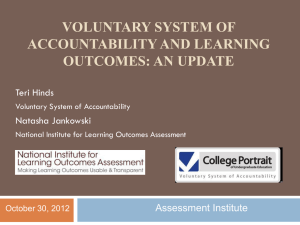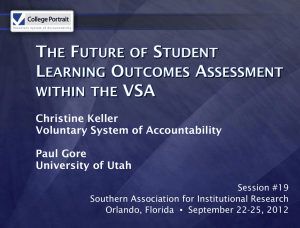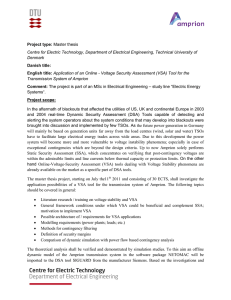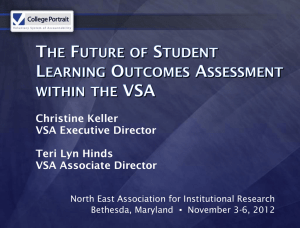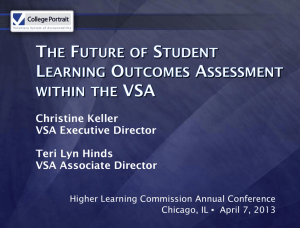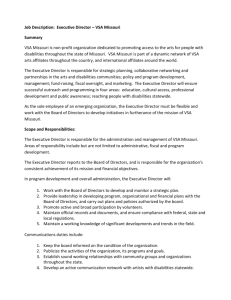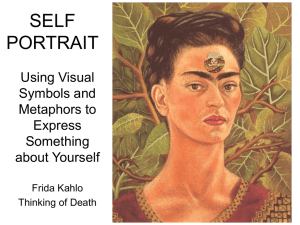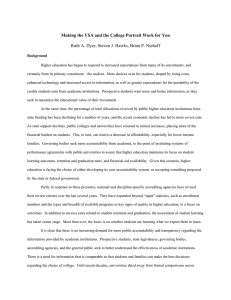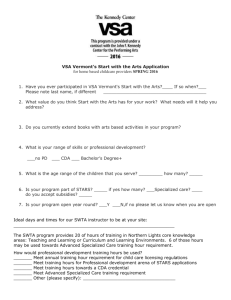Using the AAC&U VALUE Rubrics for Student Learning Outcomes
advertisement
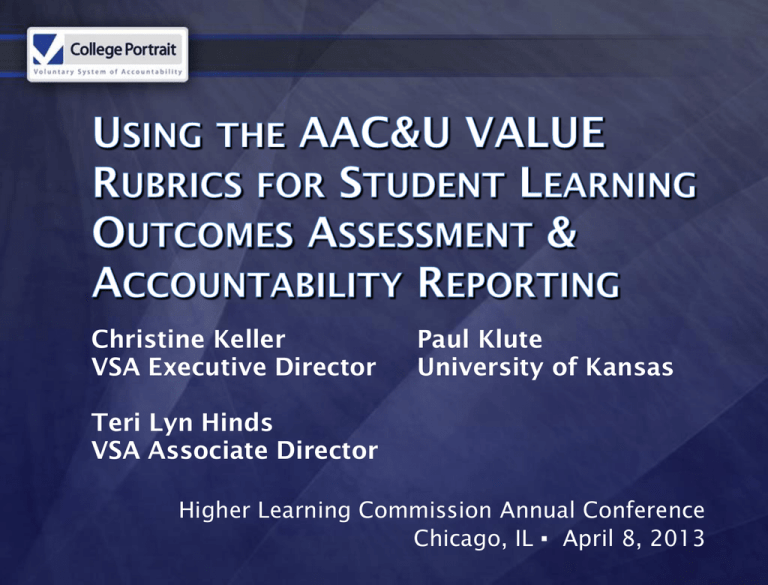
Christine Keller VSA Executive Director Paul Klute University of Kansas Teri Lyn Hinds VSA Associate Director Higher Learning Commission Annual Conference Chicago, IL ▪ April 8, 2013 • Why campus-level student learning outcomes evaluation and reporting is necessary • University of Kansas’s experience implementing the AAC&U VALUE Rubrics campus-wide • VSA College Portrait template for reporting results for accountability • Initiative launched in 2007 by public universities • Supply straightforward, comparable information on the undergraduate student experience through a common web report – the College Portrait. www.collegeportraits.org • Support innovation in the measurement and reporting of student learning outcomes • Unprecedented public challenges for higher education to be more accountable for results. • Accompanying external demands for information about student and institutional performance are growing calls for institutions and accreditors to become more transparent about what they do and the results they achieve. (Ewell, 2010) The culture of college needs to evolve, particularly with regard to “perverse institutional incentives” that reward colleges for enrolling and retaining students rather than for educating them. Quote from Richard Arum in “Academically Adrift”, 18 January 2011, Inside Higher Ed • Introduced to the campus community fall 2011 – Kansas Board of Regents began talks about learner outcomes – Reacting to feedback from HLC regarding improving assessment practices – Capitalizing on small scale assessment work being done in CTE • Undergraduate Written Communication Learner Outcomes – AAC&U Value Rubrics provided to departments to start the discussion – 60% of departments used the AAC&U Value Rubric with no changes – 95% of all UG departments participated – 90% response rate (student-level assessments) • Making it easy for departments to participate • Assessment Workshops • Primary and Secondary Readers • Undergraduate coordinators • Department Chairs – Explanation of the process – Calibration exercise – Sharing of best practices – Discussion about using the data • Provost’s Office – Provided process information – timeline, payment info, technical questions • Center for Teaching Excellence – Calibration exercises for primary and secondary readers – Workshops for departments on using the LO data – Explained the difference between grading and assessment (and how 1 assignment can be used for both) • A local paper published an article featuring a scientist’s alternative to global warming (a decline in sunspots). – By the end of this assignment you should have practice at: 1) critiquing such journalistic presentations of science; 2) researching credible information that can be brought to bear when discussing a specific claim made in the media; 3) synthesizing that information to make a coherent argument based on reliable evidence. Capstone 4 Milestones Benchmark 1 3 2 Context of and Purpose for Writing Includes considerations of audience, purpose, and the circumstances surrounding the writing task(s). Demonstrates a thorough understanding of context, audience, and purpose that is responsive to the assigned task(s) and focuses all elements of the work. Demonstrates adequate consideration of context, audience, and purpose and a clear focus on the assigned task(s) (e.g., the task aligns with audience, purpose, and context). Demonstrates awareness of context, audience, purpose, and to the assigned tasks(s) (e.g., begins to show awareness of audience's perceptions and assumptions). Demonstrates minimal attention to context, audience, purpose, and to the assigned tasks(s) (e.g., expectation of instructor or self as audience). • College Portrait re-focus from “college selection tool” to “consumer information tool to demonstrate effectiveness of educational programs” • Student Learning Outcome Instrument options: – CAAP, CLA, ETS Proficiency Profile – AAC&U VALUE rubrics – critical thinking, written communication • Common template for all 8 SLO options • Institutional context and use of results gets precedence – Five questions on administration experience – Sample characteristics compared to population characteristics – Institutions encouraged to keep explanations brief • Display of results is graphical, can include subscale results College Portrait website: www.collegeportraits.org Reports & Presentations: www.voluntarysystem.org Twitter: @VSAvoice Blog: http://vsavoice.blogspot.com/ Paul Klute, University of Kansas pklute@ku.edu Christine Keller, VSA Executive Director ckeller@aplu.org Teri Hinds, VSA Associate Director thinds@aplu.org
